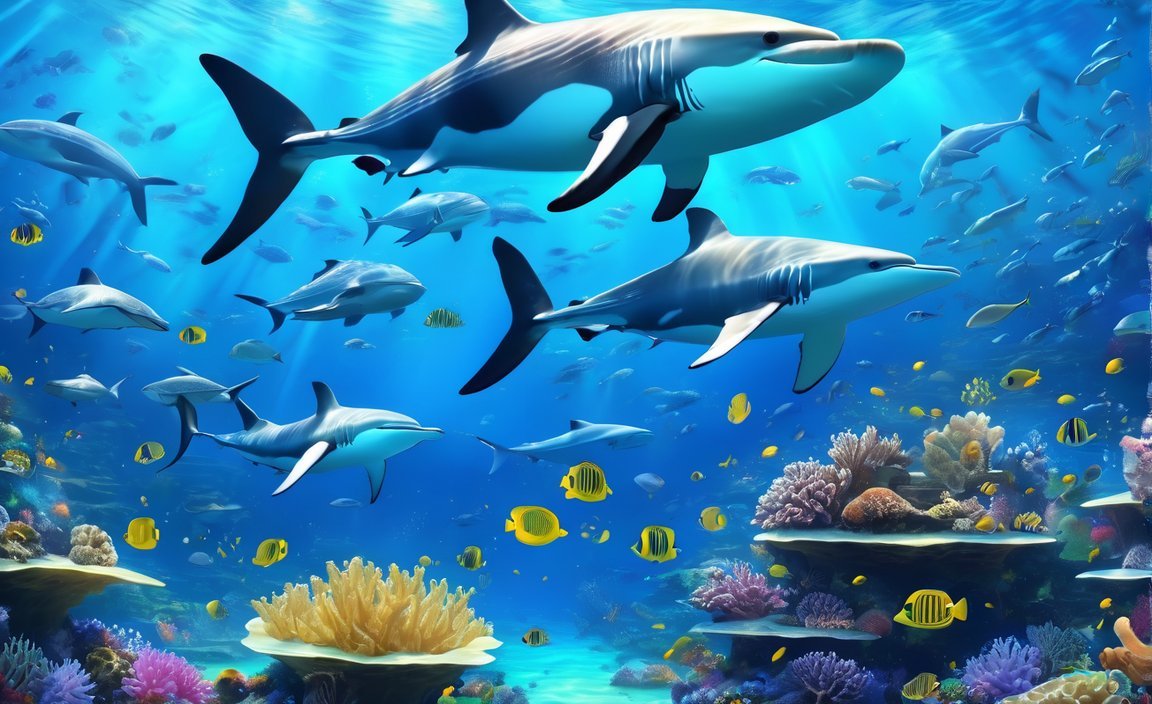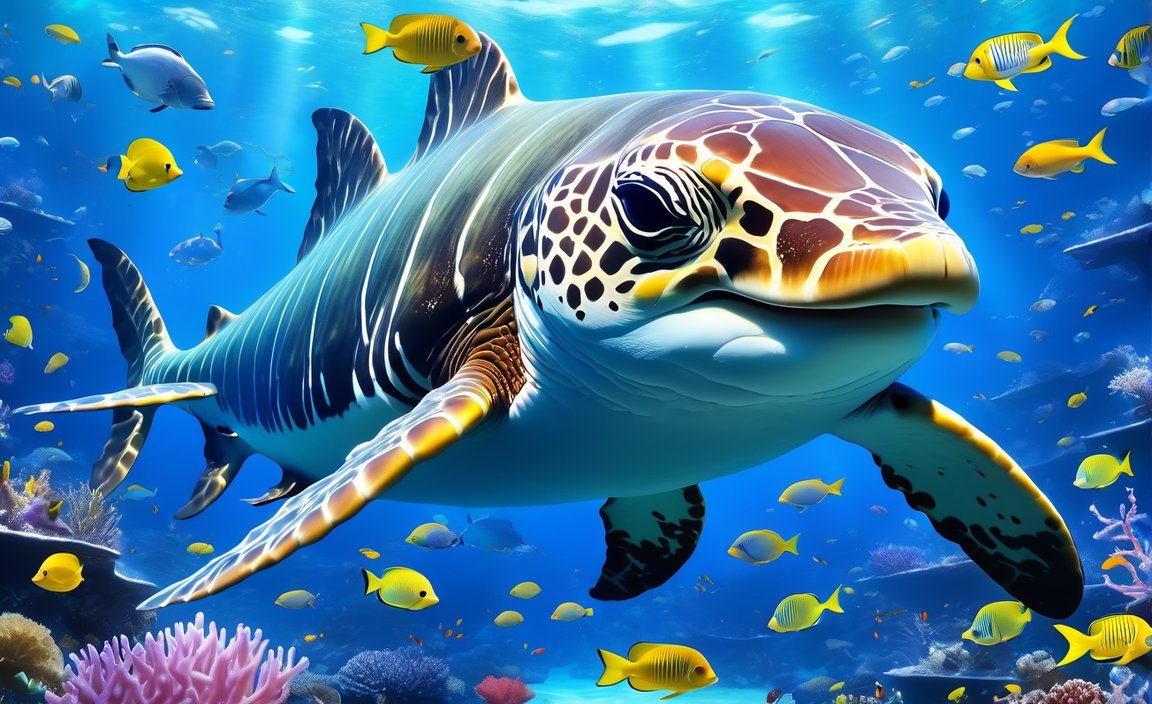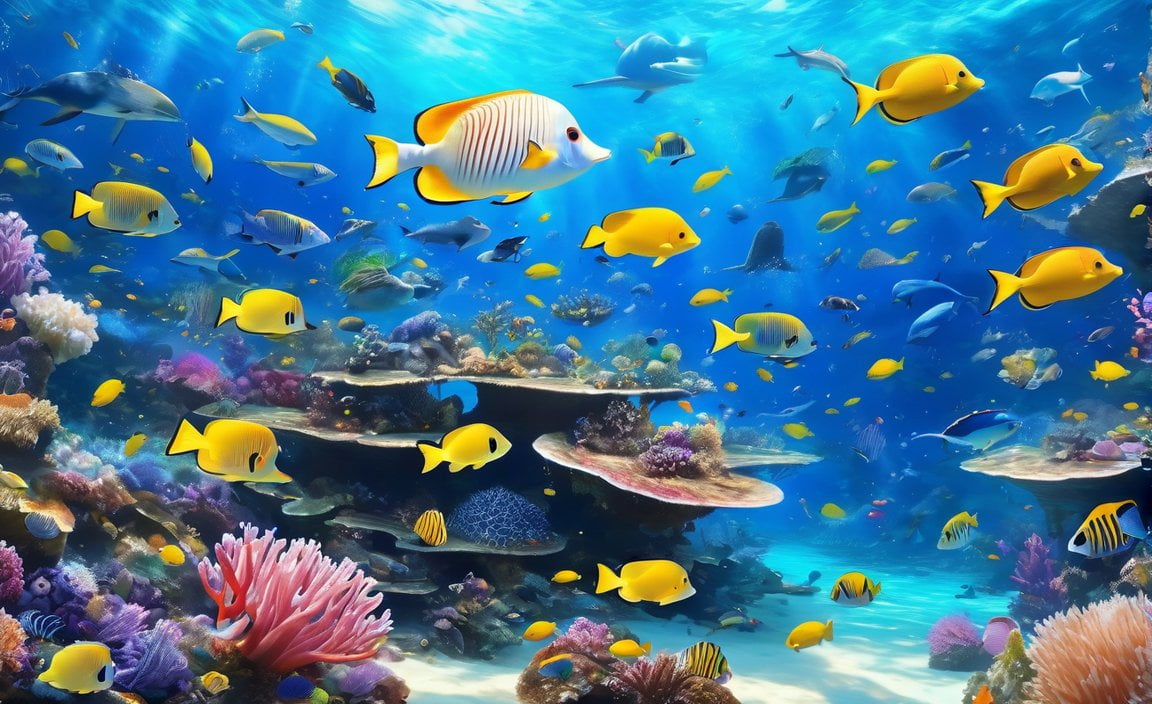Prepare to be amazed as you dive into the hidden realm of the seas, where an incredible array of awe-inspiring creatures dwell. In this article, we unveil the enchanting world of sea animals, offering you an exclusive glimpse into their extraordinary lives. Get ready to be captivated by the 10 fascinating facts that will leave you with a newfound admiration for the wonders that lie beneath the waves. From mind-boggling adaptations to mesmerizing behaviors, join us on a journey of discovery as we uncover the secrets of these remarkable marine beings. Are you ready to embark on this underwater adventure? Then let’s dive in and explore the fascinating facts about sea animals waiting to be discovered.

Key Takeaways:
- Seahorses are unique in that the male gives birth and cares for their young.
- Shrimp have their hearts located in their heads.
- Sea sponges are alive despite lacking physical features like a head, mouth, eyes, and lungs.
- Turtles can be found on every continent except Antarctica.
- The blue whale is not only the largest sea mammal but also the largest known animal in the world.
- Sea turtles have been around since the time of dinosaurs.
- Some sharks, including the great white shark, are warm-blooded.
- Sea lions, seals, and walruses are called pinnipeds due to their winged feet.
- Dolphins have excellent hearing and vision.
- Whales communicate through singing.
- Sharks have an incredible ability to detect small amounts of blood in vast amounts of water.
- The giant crab of Japan can grow as large as 12 feet across.
These facts showcase the unique and captivating characteristics of sea animals, highlighting the incredible biodiversity found within our oceans.
10 Fascinating Facts about Sea Animals
Did you know that the world beneath the waves is filled with incredible and diverse creatures? From graceful dolphins to mighty whales and mesmerizing seahorses, sea animals never fail to captivate us! Today, I’m excited to share with you 10 fascinating facts about these remarkable beings. So, let’s dive in and explore the wonders of the ocean!
1. Seahorses: The Unique Parenting Role Models
Keyword: [10 facts about sea animals]
Seahorses are truly remarkable creatures. They are the only animals in the world where the males give birth and care for their young. Quite the opposite of what we commonly see in the animal kingdom, right? This exceptional behavior makes seahorses a symbol of devotion and parental responsibility.
2. Shrimp: A Heart in its Head
Ever wondered where a shrimp’s heart is located? Prepare to be amazed because it’s situated in its head! Yes, you heard that right. This quirky anatomical feature teaches us that nature always has surprises in store for us, even in the tiniest of creatures.
3. Sea Sponges: Living Wonders without Organs
While sponges lack many physical features like a head, mouth, or brain, they are very much alive and thriving in the ocean. They serve as important filter feeders, playing a vital role in maintaining the health of marine ecosystems. Their existence reminds us that life can adapt and flourish in the most unexpected ways.
4. Turtles: Explorers of Many Lands
Turtles are fantastic travelers! You can find them on every continent, except Antarctica. These resilient creatures have adapted to various habitats, ranging from the land to the sea. With their ancient lineage that dates back to the time of dinosaurs, turtles truly embody the concept of adaptation and survival.
5. Blue Whales: Giants of the Ocean and Beyond
Who wouldn’t be in awe of the mighty blue whale? Not only are they the largest sea mammals, but they also hold the title for being the largest known animals on Earth! These gentle giants can reach astonishing lengths of up to 100 feet and weigh as much as 200 tons. Just imagine swimming alongside one of these magnificent creatures!
6. Sharks: Master Detectors
Sharks have an incredible ability to detect one part of blood in 100 million parts of water. It’s like having a built-in radar system! This astounding sense allows them to navigate the vast ocean while hunting for prey. Sharks truly showcase the wonders of evolution and the astonishing capabilities of sea animals.
7. Dolphins: Masters of Senses
Dolphins are renowned for their intelligence, but did you know they also possess remarkable hearing and vision? These sleek swimmers rely on an intricate sonar system called echolocation to navigate and communicate. Their exceptional sensory abilities remind us of the mysteries waiting to be unraveled beneath the waves.
8. Pinnipeds: Creatures with Winged Feet
Sea lions, seals, and walruses are known as pinnipeds, which means “winged feet” in Latin. These remarkable creatures have adapted to life both on land and in the water, with unique flippers that resemble wings. Their ingenious design enables them to move swiftly through the waves, showcasing the incredible diversity of marine life.
9. Whales: Singers of the Deep
Whales have their own language. Instead of words, they communicate through mesmerizing songs that can travel across vast distances in the ocean. These captivating melodies hold a powerful meaning within the whale community, allowing them to share information, seek mates, and strengthen social bonds. It’s like having a marine symphony beneath the surface.
10. Giant Crabs: Impressive Ocean Warriors
The giant crab of Japan deserves its name! These colossal crustaceans can grow as large as 12 feet across. Just picture encountering one of these impressive creatures while exploring the deep ocean depths. They serve as a reminder that the hidden world beneath the waves holds many mysteries and extraordinary beings.
Each of these facts reveals a glimpse into the incredible diversity and uniqueness of sea animals. From the seahorse’s extraordinary parenting to the blue whale’s awe-inspiring size, the wonders of marine life surpass our imagination. So let’s cherish and protect these precious creatures who call the ocean home.
For more interesting facts about sea animals, feel free to check out the following sources:
– All That’s Interesting – Ten Amazing Facts About Ocean Animals
– FirstCry – Facts & Information About Sea Animals for Kids
Here are some interesting facts that you might not know about dogs in Hindi. Click here to learn more about these fascinating creatures!
Did you know that ground pollution can have serious consequences on our environment? Discover 10 facts about ground pollution that will make you think twice about how we treat our planet.
The ocean is filled with amazing creatures! Dive into the world of marine animals with these 10 captivating facts that will leave you in awe of their beauty and diversity.
Looking to learn more about marine mammals? Click here to uncover 10 intriguing facts about these intelligent and fascinating creatures of the sea.
Explore the wonders of the sea and discover 10 facts about ocean animals that will take you on a journey through the depths of the ocean and introduce you to some incredible marine species.
If you’re a pet lover, you won’t want to miss these 10 amazing facts about pets. From their quirky behaviors to their incredible abilities, you’ll be amazed by the world of our furry friends.
Are you curious about slugs and snails? Click here to uncover 10 fascinating facts about these slimy yet fascinating creatures that play an important role in our ecosystem.
Snapping turtles are known for their powerful bite and unique appearance. Dive into their world with these 10 intriguing facts that will leave you amazed by these ancient reptiles.
Outline 3: Intriguing Behaviors of Sea Creatures
Sea animals have always captivated our imagination with their fascinating behaviors and adaptations. From gender-changing fish to giant squids with enormous eyes, the marine world is full of wonders. In this article, we will dive deep into the intriguing behaviors of sea creatures, revealing 10 facts that will leave you in awe.
1. Gender-Changing Abilities
Did you know that certain fish have the remarkable ability to change their gender? These unique creatures, such as the clownfish and the wrasses, can alter their reproductive status depending on various factors like social hierarchy or the absence of certain genders in their population. It’s a natural phenomenon that showcases the incredible adaptability and flexibility of sea animals.
2. Giant Squids and Their Enormous Eyes
When it comes to eye size, no other animal surpasses the giant squid. With eyes measuring up to 10 inches in diameter, this deep-sea dweller holds the record for having the largest eyes of any creature on Earth. These massive eyes allow the giant squid to spot prey and detect movement in the murky depths of the ocean.
3. Blue Blood and Bacterial Detection
Ever heard of a creature with blue blood? Enter the horseshoe crab, a fascinating marine animal that has copper-based blue blood. This unique blood plays a crucial role in their immune system, as it can detect bacterial contamination in medical equipment. Scientists extract an important compound, Limulus amebocyte lysate (LAL), from their blood, which is used to test for the presence of harmful bacteria in medicines.
4. Deadly Great White Sharks
When it comes to shark species, the great white shark stands out as the deadliest predator. Not only is it a formidable hunter, but it is also the only warm-blooded shark. This warm-blooded adaptation allows the great white shark to maintain a higher body temperature than the surrounding water, giving it an edge in colder ocean regions.
5. Thresher Sharks’ Scythe-Like Tails
Imagine a shark with a tail as long as its body. That’s the thresher shark! These incredible creatures possess a tail that can reach lengths even greater than their bodies. The elongated, scythe-like tail is used as a powerful hunting tool, allowing the thresher sharks to stun their prey with quick and deadly strikes.
6. Moray Eels’ Unique Respiratory Process
Next time you see a moray eel opening and closing its mouth, remember it’s not aggression—it’s breathing! These fascinating creatures don’t have the luxury of gills like most fish. Instead, they rely on their strong jaws and pharyngeal muscles to draw water into their mouths and force it over their gills, ensuring a constant flow of oxygen-rich water through their respiratory system.
7. Frogfish and Their Unconventional Eating Habits
Ever wondered how frogfish with no teeth manage to eat? Well, these remarkable creatures have a unique method of feeding. Instead of relying on teeth, frogfishes engulf their prey whole. Their expandable stomachs allow them to swallow prey almost as large as themselves. It’s a sight to behold!
8. Gender Change in Fish
Some fish possess the extraordinary ability to change their gender during their lifetime. This phenomenon, known as sequential hermaphroditism, is observed in species like the clownfish and the wrasses. It allows them to adapt to their surroundings, maintain stable populations, and increase their chances of reproductive success. Gender-changing fish truly showcase the wonders of nature.
9. The World’s Smallest and Largest Fish
In the vast ocean, we find extreme diversity in fish sizes. The world’s smallest fish, the Paedocypris fish, measures less than a centimeter in length. On the other end of the spectrum, we have the impressive whale shark, the largest fish in the world, reaching lengths of up to 40 feet. These contrasting sizes demonstrate the remarkable range of species in our oceans.
10. Tool-Use Abilities of Ocean Animals
While we often associate tool use with land animals, ocean creatures also display remarkable problem-solving abilities. For example, certain octopuses have been observed using coconut shells as protective armor. Dolphins have been known to use sponges to protect their snouts while foraging on the ocean floor. These examples highlight the intelligence and ingenuity of sea animals.
Key Takeaways:
- Some fish can change their gender, demonstrating the adaptability of sea creatures.
- Giant squids have the largest eyes of any animal, allowing them to thrive in the depths of the ocean.
- Horseshoe crabs have blue blood used to detect bacterial contamination in medical equipment.
- Great white sharks are the deadliest shark species and the only warm-blooded sharks.
- Thresher sharks possess long scythe-like tails used for stunning and hunting prey.
- Moray eels open and close their mouths as a respiratory process, not out of aggression.
- Frogfishes lack teeth and swallow their prey whole, thanks to their expandable stomachs.
- Sequential hermaphroditism allows certain fish to change their gender to adapt to their environment.
- The world’s smallest fish, the Paedocypris fish, measures less than a centimeter, while the whale shark is the largest fish, reaching up to 40 feet in length.
- Ocean animals like octopuses and dolphins display remarkable tool-use abilities, showcasing their problem-solving skills.
Sources:
– NOAA Fisheries
– Ocean Conservancy
Outline 4: Unusual and Unique Sea Animal Species
The Earth’s oceans are a treasure trove of fascinating creatures, many of which remain undiscovered in the vast depths. From ancient predators to mesmerizing mollusks, the diversity of sea animals is nothing short of extraordinary. In this article, we’ll dive into the depths of the ocean to uncover ten unusual and unique sea animal species that you may not have heard of before. So, let’s embark on this captivating journey and explore the wonders that lie beneath the waves.
The Immortal Jellyfish: A Fountain of Youth
Did you know that there is a jellyfish with the remarkable ability to reverse aging? Meet the immortal jellyfish. This extraordinary creature has the power to regenerate its cells and transform back into its juvenile form. It essentially cheats death, making it truly unique among its peers.
The Color-Changing Cuttlefish: Nature’s Master of Camouflage
Imagine having the ability to change your appearance at will. Well, the color-changing cuttlefish can do just that! With the help of specialized cells called chromatophores, these cephalopods can instantly alter their skin color, pattern, and texture to blend seamlessly into their surroundings. They are truly masters of disguise in the underwater world.
The Anglerfish: A Frightening Beauty
In the depths of the ocean, a creature lurks, possessing both beauty and horror. The anglerfish may appear frightening with its menacing teeth and beady eyes, but its bioluminescent lure is a work of art. Using a natural fishing rod protruding from its head, this deep-sea dweller attracts unsuspecting prey with a mesmerizing glow.
The Leafy Sea Dragon: Nature’s Mysterious Artwork
Nature never ceases to amaze us with its capacity for creativity. The leafy sea dragon is a true testament to this. Resembling a piece of floating seaweed with its intricate leaf-like appendages, this remarkable creature gracefully drifts through the ocean. Its camouflage is so perfect that it becomes one with its surrounding kelp forests.
The Dumbo Octopus: An Enchanting Oddity
Deep beneath the waves, a whimsical creature gracefully glides through the darkness. The dumbo octopus, named after the Disney character, boasts ear-like fins that resemble the adorable protagonist’s ears. With a mesmerizing appearance and a unique mode of propulsion, this enchanting oddity captivates all who lay eyes on it.
The Vampire Squid: A Living Fossil
Venturing into the mysterious depths of the ocean, we encounter a living fossil: the vampire squid. Despite its name, this ancient creature is not a bloodsucker, but it does possess a cloak-like webbing between its tentacles that gives it a vampiric appearance. With its glowing eyes and bioluminescent defensive display, this enigmatic cephalopod is a true marvel of evolution.
The Mantis Shrimp: A Punch Like No Other
Underestimated by its small size, the mantis shrimp is a fierce predator armed with an incredible weapon. With a punch that rivals a bullet in speed, this crustacean is capable of shattering shells and breaking aquarium glass. Its vibrant colors and unique eyes, which perceive an extraordinary range of colors, add to its undeniable allure.
The Blobfish: A Surreal Underwater Delight
Navigating the frigid depths of the ocean, we encounter a creature that, quite literally, looks like a melting blob. The blobfish has a somewhat comical appearance, with its droopy, gelatinous body. Adapting to survive in the extreme conditions of the deep sea, this unusual fish is a testament to the remarkable resilience of life in the underwater realm.
The Narwhal: A Majestic Sea Unicorn
Unicorns may be mythical creatures, but in the ocean, we find the next best thing: the narwhal. Known as the “unicorn of the sea,” this arctic-dwelling whale possesses an elongated tooth, or tusk, that can grow up to 10 feet long. Despite its majestic appearance, the purpose of the narwhal’s tusk remains a mystery, adding an air of intrigue to this extraordinary animal.
The Axolotl: A Salamander with Superpowers
Venturing beyond the marine realm, we stumble upon an incredible amphibian: the axolotl. With its adorable smile and regenerative abilities, this Mexican salamander possesses superpowers unlike any other creature on Earth. If injured, the axolotl can regrow lost body parts, including limbs, spinal cord, and even parts of its heart and brain.
Key Takeaways:
– The immortal jellyfish has the unique ability to reverse aging, making it truly extraordinary.
– The color-changing cuttlefish can alter its appearance to match its surroundings, showcasing nature’s masterful camouflage.
– Anglerfish use a bioluminescent lure to attract prey, combining both beauty and horror in one creature.
– The leafy sea dragon blends seamlessly into its environment with its intricate leaf-like appendages.
– The dumbo octopus captivates with its whimsical appearance and unique mode of propulsion.
– The vampire squid, a living fossil, mesmerizes with its glowing eyes and bioluminescent display.
– The mantis shrimp possesses a punch that rivals a bullet, and its vibrant colors and extraordinary eyes make it truly captivating.
– The blobfish, with its droopy gelatinous appearance, adapts to extreme deep-sea conditions.
– The narwhal, known as the “unicorn of the sea,” possesses a long tusk that adds an air of mystery to this majestic creature.
– The axolotl, a Mexican salamander, has the remarkable ability to regrow lost body parts, making it a true superpower among amphibians.
Sources:
- National Geographic – One-of-a-Kind Sea Creatures
- Treehugger – 15 Bizarre Deep Sea Creatures
Outline 5: The importance of preserving marine ecosystems
[Discover the Wonders: 10 Fascinating Facts about Sea Animals]
Sea animals inhabit a mesmerizing world beneath the waves, full of wonders and mysteries. Understanding the importance of preserving marine ecosystems is essential for the sustainability of our planet and the well-being of future generations. Through these 10 fascinating facts about sea animals, we can gain a deeper appreciation for the incredible biodiversity and delicate balance of life in our oceans.
1. The Role of Sea Animals in Marine Ecosystems
Sea animals play a vital role in maintaining the health and productivity of marine ecosystems. From tiny plankton that form the base of the food chain to mighty predators at the top, each species has a unique function that contributes to the overall balance and stability of the ecosystem. Without these animals, the entire ecosystem would be disrupted, causing a ripple effect throughout the food web.
2. The Ocean’s Oxygen Supply
Did you know that over half of the world’s oxygen comes from the ocean? Sea animals, particularly marine plants like phytoplankton and kelp, are responsible for producing oxygen through a process called photosynthesis. Without these oxygen-producing organisms, life on Earth as we know it would not be possible.
3. Marine Biodiversity and Ecosystem Resilience
The preservation of marine ecosystems is crucial for maintaining biodiversity and the resilience of these habitats. Each sea animal contributes to the overall biodiversity by occupying a specific ecological niche. The loss of even a single species can disrupt the delicate balance and resilience of the entire ecosystem.
4. Economic and Social Importance
In addition to their ecological significance, marine ecosystems also provide valuable resources to humans. Fisheries and aquaculture support livelihoods and provide a source of food for millions of people worldwide. Furthermore, marine-based industries such as tourism and pharmaceuticals rely on the health and diversity of marine ecosystems for economic opportunities.
5. Climate Regulation and Carbon Sequestration
Healthy marine ecosystems play a crucial role in regulating the Earth’s climate and mitigating climate change. Sea animals, particularly marine plants and corals, absorb carbon dioxide from the atmosphere, helping to reduce the effects of greenhouse gases. Additionally, coastal habitats like mangroves and seagrass beds serve as carbon sinks, storing large amounts of carbon in their biomass and sediments.
Key Takeaways:
- Marine ecosystems are essential for maintaining the health and productivity of the oceans and the planet as a whole.
- Sea animals contribute to the balance and stability of marine ecosystems.
- Marine organisms, especially plants, produce over half of the world’s oxygen.
- The preservation of marine ecosystems ensures biodiversity and ecosystem resilience.
- Marine resources provide economic opportunities and support livelihoods.
- Healthy marine ecosystems help regulate the Earth’s climate and mitigate climate change.
References:
[^1^]: Preservation of the Marine Ecosystem | Department of Economic …
[^6^]: How preserving biodiversity in our oceans can save human lives – Oceana

FAQ
Q1: What are some interesting facts about sea animals?
A1: Some interesting facts about sea animals include seahorses being the only animals in which the male gives birth and cares for their young, turtles inhabiting every continent except Antarctica, and the blue whale being the largest known animal in the world.
Q2: Are all sea animals alive even if they lack physical features like a head or brain?
A2: Yes, sea sponges are alive despite lacking physical features such as a head, mouth, eyes, feelers, bones, heart, lungs, or brain.
Q3: Are there any warm-blooded sharks?
A3: Yes, some sharks, like the great white shark, are warm-blooded.
Q4: What is the largest sea mammal and how big can it grow?
A4: The blue whale is not only the largest sea mammal but also the largest known animal in the world. It can grow up to 100 feet long.
Q5: How long have sea turtles existed?
A5: Sea turtles have existed since the time of the dinosaurs, making them ancient creatures in the ocean.
- Star Ring Trends: Etsy vs Amazon - March 28, 2025
- Boost Pollinator Habitats: Baby Blue Eyes Sustainable Farming Guide - March 28, 2025
- Protect Big Black Bears: Effective Conservation Strategies - March 28, 2025
















